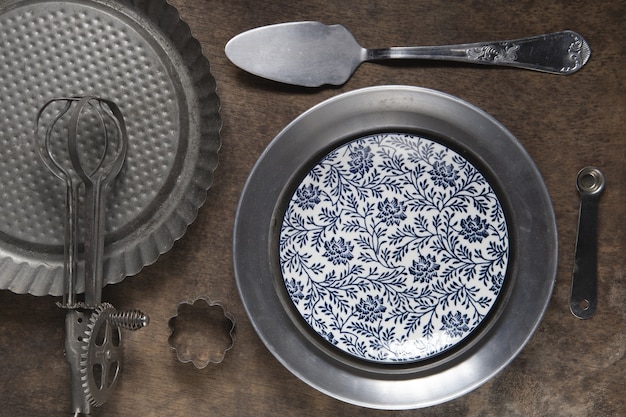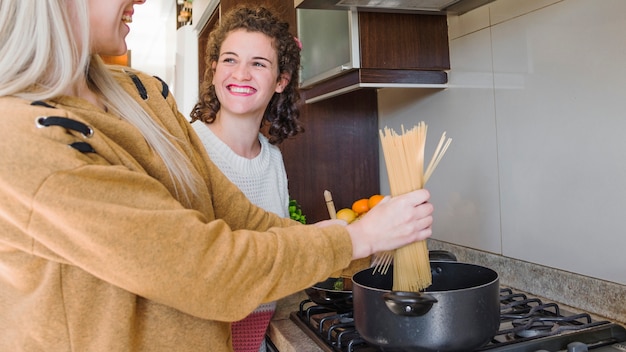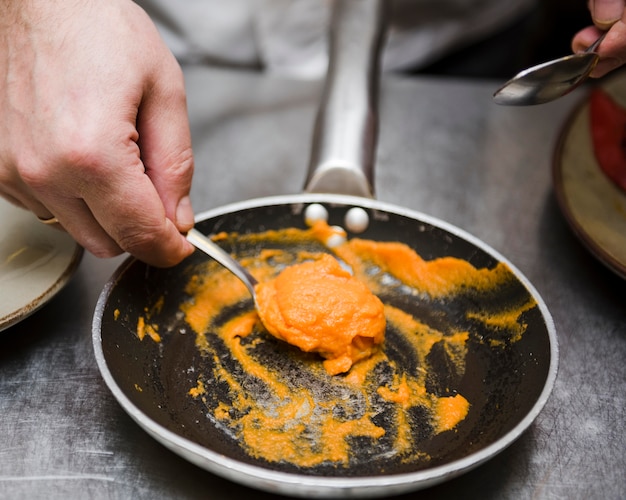(Part 1) Choosing Your Cast Iron Frying Pan

The Different Types of Cast Iron
Seasoned Cast Iron: This is the classic, the OG of cast iron. These pans are pre-seasoned with a layer of oil, which gives them that characteristic dark, non-stick surface. They're ready to go right out of the box, which is a huge plus for beginners. Unseasoned Cast Iron: A blank slate, waiting for you to put your personal touch on it. These pans are typically cheaper than pre-seasoned ones, but you'll need to season them yourself (more on that later).What Size Pan Should You Get?
This really depends on your cooking needs. Small (8-9 inch): Perfect for solo cooks or couples, ideal for things like eggs, pancakes, or a single steak. Medium (10-12 inch): The workhorse of the kitchen! This size is perfect for most everyday cooking needs, whether you're making a stir-fry for two or a skillet dinner for the family. Large (12-inch and up): For serious cooks and large families, these pans can handle everything from big roasts to massive batches of cookies.Do You Need a Handle or a Loop?
Now, let's talk about handles. Single Handle: The most common type, perfect for general use on the stovetop. Loop Handle: Designed for oven use, as it allows you to easily lift the pan out of the oven with an oven mitt. Double Handle: This provides a secure grip for larger pans, especially when you're moving them around.Cast Iron vs. Enameled Cast Iron: Which is Right for You?
Enameled cast iron is a bit of a game-changer. It's cast iron with a coating of enamel, which makes it easier to clean and less prone to rust. Enameled Cast Iron: Great for beginners, as it's easy to maintain and looks gorgeous. However, it doesn't have the same level of heat retention as traditional cast iron. Traditional Cast Iron: A more experienced cook's choice, as it requires more care but delivers incredible flavor and cooking results.(Part 2) Seasoning Your Cast Iron Frying Pan

Why is Seasoning Important?
Seasoning creates a protective layer on the pan, preventing rust and allowing food to release easily. It’s like a protective armor that keeps your pan in peak condition.How to Season Your cast iron pan
This is a simple process that takes a bit of time but is totally worth it.- Wash and Dry Your Pan: Give it a good scrub with hot soapy water. Make sure you use a mild dish soap and avoid harsh detergents. Dry the pan completely, ideally with a kitchen towel.
- Coat the Pan with Oil: Use a high-heat oil like flaxseed, grapeseed, or avocado oil. Rub a thin layer evenly over the entire surface of the pan, using a paper towel or a clean cloth. Don't be afraid to get your hands dirty!
- Heat the Pan in the Oven: Place the pan upside down on a baking sheet in your oven. Bake at 350°F (175°C) for at least 1 hour. This will allow the oil to polymerize and create that hard, non-stick surface.
- Let it Cool Completely: Remove the pan from the oven and let it cool down completely. Don't rush this step! Let the oil settle and solidify.
- Repeat for Best Results: For a super-tough coating, repeat the seasoning process a few times. You'll notice the pan getting darker and smoother with each session.
How to Tell if Your Cast Iron Pan is Properly Seasoned
A properly seasoned cast iron pan should have a dark, smooth, and slightly oily surface. It should feel almost silky to the touch. If you see any bare spots or if the pan feels rough, it means the seasoning is incomplete and needs a few more rounds of seasoning.(Part 3) Cooking with Your Cast Iron Frying Pan

The Benefits of Cooking with Cast Iron
Even Heat Distribution: Cast iron is known for its ability to retain and distribute heat evenly. This means your food cooks consistently, without hot spots or cold spots. Superior Sear: The high heat capacity of cast iron is perfect for searing meats. You'll get that delicious, crispy crust that you crave. Durable and Long-Lasting: Cast iron is practically indestructible. It can withstand high heat and repeated use without warping or breaking. Natural Non-Stick: A properly seasoned cast iron pan will have a naturally non-stick surface. It's a joy to cook eggs, pancakes, or delicate fish fillets in a seasoned cast iron pan.Important Tips for Cooking with Cast Iron
- Preheat the Pan: Always preheat your cast iron pan over medium-high heat for about 5 minutes before you start cooking. This will ensure that the pan is hot enough to sear your food properly.
- Use the Right Oil: High-heat oils like avocado oil, grapeseed oil, or coconut oil are ideal for cooking in cast iron. They have a high smoke point and won't break down at high temperatures.
- Avoid Using Acidic Foods: Acidic foods like tomatoes can damage the seasoning on your cast iron pan. If you're making a recipe with acidic ingredients, try lining the pan with parchment paper or using a different pan.
- Don't Overcrowd the Pan: Give your food some space to cook evenly. Don't overload the pan, or it won't be able to heat up properly.
(Part 4) Caring for Your Cast Iron Frying Pan
Cast iron is a loyal friend. It needs a little TLC, but it'll reward you with years of delicious cooking.How to Clean Your Cast Iron Pan
- Clean it With Hot Water and a Scrub Brush: After cooking, wash your pan with hot water and a scrub brush. You can use a small amount of mild dish soap, but avoid harsh detergents.
- Don't Soak Your Pan: Soaking your cast iron pan in water for too long can damage the seasoning.
- Dry it Immediately: After washing, dry your pan immediately with a towel or by placing it on the stovetop over low heat for a few minutes.
- Re-season Regularly: Re-season your pan regularly to maintain its non-stick surface. It doesn't have to be after every use, but a good re-seasoning every few weeks will keep it in tip-top shape.
What to Do If Your Cast Iron Pan Starts to Rust
It's normal for a cast iron pan to develop a little bit of rust, especially if you haven't used it in a while. Don't panic! It's easy to fix.- Scrub Away the Rust: Use a scrub brush and hot water to remove the rust. If the rust is stubborn, you can try a paste made from baking soda and water.
- Re-season the Pan: After cleaning the rust, re-season the pan to protect it from rusting again.
(Part 5) Cast Iron Frying Pan Recipes
Now for some inspiration! Here are a few delicious recipes that you can make in your trusty cast iron frying pan:pan-seared steak
Ingredients: 1 (1-inch) thick steak (ribeye or new york strip) 1 tbsp olive oil Salt and pepper to tasteInstructions:1. Heat a cast iron frying pan over medium-high heat for about 5 minutes.2. Season the steak generously with salt and pepper.3. Add the olive oil to the hot pan.4. Sear the steak for 2-3 minutes per side, or until browned and cooked to your liking.5. Remove the steak from the pan and let it rest for 5 minutes before slicing and serving.crispy skin Salmon
Ingredients: 1 lb salmon fillet, skin-on 1 tbsp olive oil Salt and pepper to taste 1/4 cup chopped fresh herbs (dill, parsley, or chives) 1 lemon wedgeInstructions:1. Heat a cast iron frying pan over medium-high heat for about 5 minutes.2. Season the salmon fillet generously with salt and pepper.3. Add the olive oil to the hot pan.4. Place the salmon fillet, skin-side down, in the pan and cook for 5-7 minutes, or until the skin is crispy and the flesh is cooked through.5. Flip the salmon fillet and cook for an additional 1-2 minutes.6. Remove the salmon fillet from the pan and sprinkle with chopped fresh herbs.7. Serve immediately with a lemon wedge.Pancakes
Ingredients: 1 cup all-purpose flour 1 tsp baking powder 1/2 tsp salt 1 tbsp sugar 1 egg 1 cup milk 2 tbsp melted butterInstructions:1. Heat a cast iron frying pan over medium heat for about 5 minutes.2. In a large bowl, whisk together the flour, baking powder, salt, and sugar.3. In a separate bowl, whisk together the egg, milk, and melted butter.4. Gradually add the wet ingredients to the dry ingredients, whisking until just combined.5. Add a dollop of batter to the hot pan for each pancake.6. Cook for 2-3 minutes per side, or until golden brown and cooked through.7. Serve immediately with your favorite toppings, such as butter, syrup, or fruit.dutch oven braised short ribs
Ingredients: 2 lbs boneless short ribs, cut into 2-inch pieces 1 tbsp olive oil 1 onion, chopped 2 carrots, chopped 2 celery stalks, chopped 2 cloves garlic, minced 1 cup red wine 1 cup beef broth 1 tbsp tomato paste 1 tsp dried thyme 1/2 tsp salt 1/4 tsp black pepperInstructions:1. Preheat a cast iron Dutch oven over medium-high heat.2. Season the short ribs generously with salt and pepper.3. Add the olive oil to the hot Dutch oven.4. Sear the short ribs on all sides, about 5 minutes per side, until browned.5. Remove the short ribs from the Dutch oven and set aside.6. Add the onion, carrots, and celery to the Dutch oven and cook until softened, about 5 minutes.7. Add the garlic and cook for 1 minute more.8. Add the red wine, beef broth, tomato paste, thyme, salt, and pepper to the Dutch oven.9. Bring the mixture to a simmer.10. Return the short ribs to the Dutch oven.11. Cover the Dutch oven and braise in the oven at 325°F (160°C) for 2-3 hours, or until the short ribs are fork-tender.12. Remove the short ribs from the Dutch oven and set aside.13. Skim any excess fat from the braising liquid.14. Bring the braising liquid to a boil over medium heat.15. Reduce the braising liquid until it has thickened slightly, about 5 minutes.16. Return the short ribs to the Dutch oven and coat with the thickened braising liquid.17. Serve immediately with your favorite sides.(Part 6) Maintaining Your Cast Iron Frying Pan
Keeping your cast iron pan in tip-top shape is like nurturing a prized possession. A little care goes a long way!How Often Should You Re-season Your Cast Iron Pan?
You don't need to re-season your cast iron pan after every use, but it's a good idea to give it a light re-seasoning every few weeks. If you notice the seasoning starting to look dull or thin, or if you see any bare spots, it's time for a re-seasoning.How to Re-season Your Cast Iron Pan
The re-seasoning process is very similar to the initial seasoning:- Wash and Dry the Pan: Give it a good scrub with hot soapy water. Make sure to dry it completely.
- Coat the Pan with Oil: Rub a thin layer of oil (flaxseed, grapeseed, or avocado oil) over the entire surface of the pan. Use a paper towel or a clean cloth.
- Heat the Pan in the Oven: Place the pan upside down on a baking sheet in your oven. Bake at 350°F (175°C) for at least 1 hour.
- Let it Cool Completely: Remove the pan from the oven and let it cool completely.
What to Do If Your Cast Iron Pan Gets Burnt
Even the best cooks have their moments. If your cast iron pan gets burnt, don't give up on it!- Scrub Away the Burnt Food: Use a scrub brush and hot water to remove as much of the burnt food as possible.
- Boil Water in the Pan: Fill the pan with water and bring it to a boil. Let it simmer for a few minutes, then pour out the water and scrub again.
- Re-season the Pan: After cleaning the burnt food, re-season the pan to protect it from rusting.
(Part 7) Cast Iron Frying Pans: Myths and Misconceptions
It's true that cast iron frying pans have been around for a long time, but that doesn't mean there aren't some myths floating around.Myth 1: Cast Iron Pans Are Difficult to Clean
This is a total myth! While cast iron pans require a little more attention than other types of pans, they're not that difficult to clean. Just scrub them with hot water and a scrub brush, and don't forget to dry them thoroughly after washing.
Myth 2: You Can't Use Soap to Clean Cast Iron Pans
You can actually use a small amount of mild dish soap to clean your cast iron pan. Just don't use harsh detergents, and make sure to rinse it well with hot water.
Myth 3: Cast Iron Pans Are Only Good for Cooking Certain Foods
Wrong again! Cast iron pans are incredibly versatile and can be used to cook just about anything, from pancakes to steaks to vegetables. They're particularly well-suited for searing, browning, and baking.
Myth 4: Cast Iron Pans Are Too Heavy
This one has a bit of truth to it. Cast iron pans are heavier than other types of pans. But that extra weight helps to retain heat better, which is a good thing for cooking.
Myth 5: Cast Iron Pans Rust Easily
While cast iron is prone to rusting if not properly cared for, with proper seasoning and cleaning, it will last for years without any issues.
(Part 8) FAQs
Q: Can I use my cast iron frying pan in the oven?
Yes, most cast iron pans are oven-safe up to 500°F (260°C). Just make sure that the handle is oven-safe as well.
Q: Can I use my cast iron frying pan on an induction cooktop?
Not all cast iron pans are compatible with induction cooktops. To use a cast iron pan on an induction cooktop, it needs to have a magnetic base. You can usually find induction-compatible cast iron pans at most kitchen stores.
Q: Is it okay to use my cast iron frying pan on the stovetop over high heat?
Absolutely! One of the best things about cast iron pans is that they can handle high heat. Just make sure to preheat the pan before you start cooking.
Q: How do I know when my cast iron frying pan is seasoned properly?
A properly seasoned cast iron pan should have a dark, smooth, and slightly oily surface. It should feel almost silky to the touch. If you see any bare spots, it means the seasoning is incomplete.
Q: What are some good resources for learning more about cast iron frying pans?
There are lots of great resources out there for learning more about cast iron frying pans. Some of my favorites include:
- The Lodge Cast Iron website: Lodge Cast Iron is a reputable manufacturer of cast iron cookware, and their website has a wealth of information about cast iron pans.
- The Cast Iron Collective website: This website is dedicated to all things cast iron, and it offers a wide range of articles, recipes, and tips.
- YouTube: There are tons of helpful videos on YouTube about cast iron pans, from how to season them to how to cook with them.
You're now equipped to embrace the world of cast iron! Get your pan, season it, and get cooking. Happy frying!
Everyone is watching

How to Cook Frozen Lobster Tails Perfectly: A Step-by-Step Guide
RecipesLobster. Just the word conjures up images of lavish meals, special occasions, and a taste of luxury. But let's...

Pigs in a Blanket Cooking Time: How Long to Bake for Perfect Results
RecipesAh, pigs in a blanket. Just the name conjures up images of those delightful little parcels of crispy pastry en...

Pork Fillet Cooking Time: How Long to Cook It Perfectly
RecipesPork fillet, or tenderloin as it's sometimes called, is a real favourite in our house. It's so versatile, and...

The Ultimate Guide to Tender, Juicy Pulled Pork
RecipesRight, let's talk pulled pork. It's one of those dishes that just screams "comfort food," doesn't it? I mean...

The Ultimate Guide to Cooking Sweet Potatoes: From Roasting to Mashing
RecipesSweet potatoes. Just the name conjures up images of warm, comforting dishes, bursts of vibrant color, and a to...
